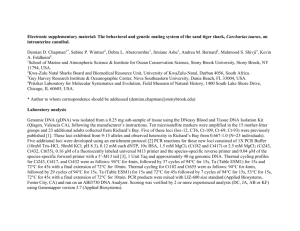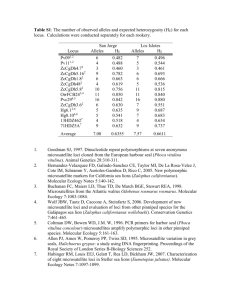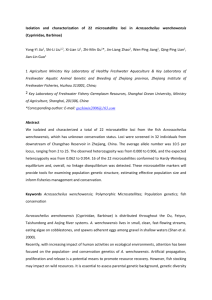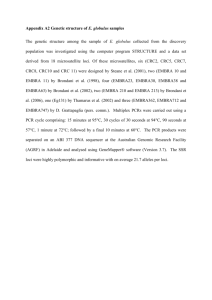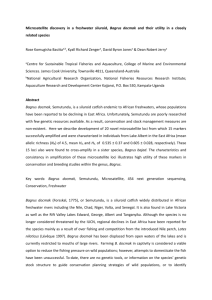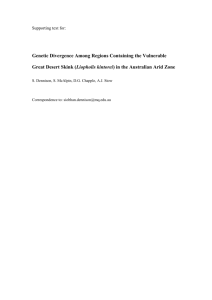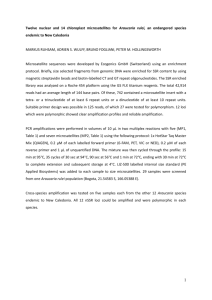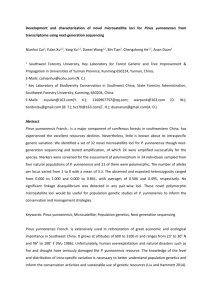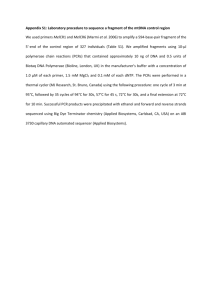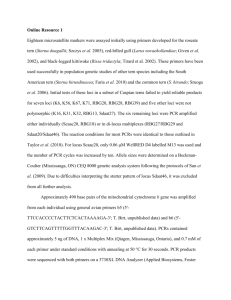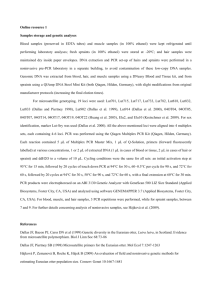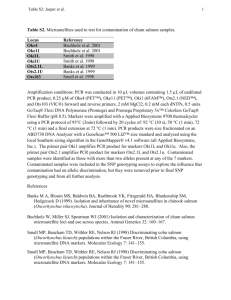Development and multiplex genotyping of 20 microsatellite markers
advertisement
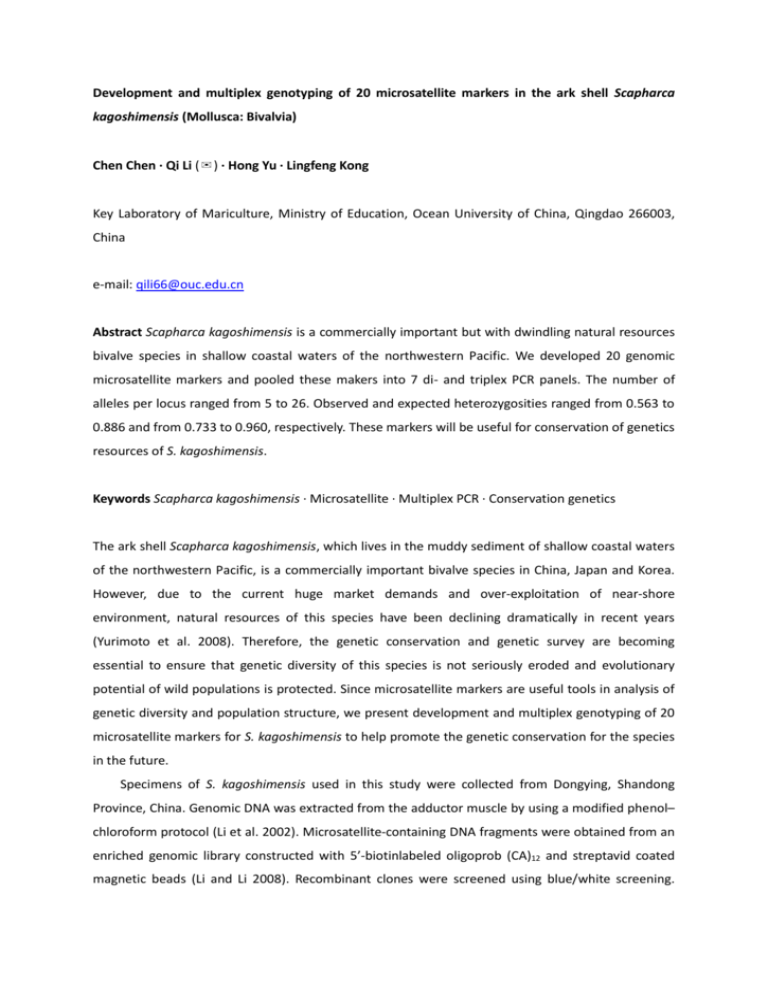
Development and multiplex genotyping of 20 microsatellite markers in the ark shell Scapharca kagoshimensis (Mollusca: Bivalvia) Chen Chen · Qi Li (✉) · Hong Yu · Lingfeng Kong Key Laboratory of Mariculture, Ministry of Education, Ocean University of China, Qingdao 266003, China e-mail: qili66@ouc.edu.cn Abstract Scapharca kagoshimensis is a commercially important but with dwindling natural resources bivalve species in shallow coastal waters of the northwestern Pacific. We developed 20 genomic microsatellite markers and pooled these makers into 7 di- and triplex PCR panels. The number of alleles per locus ranged from 5 to 26. Observed and expected heterozygosities ranged from 0.563 to 0.886 and from 0.733 to 0.960, respectively. These markers will be useful for conservation of genetics resources of S. kagoshimensis. Keywords Scapharca kagoshimensis · Microsatellite · Multiplex PCR · Conservation genetics The ark shell Scapharca kagoshimensis, which lives in the muddy sediment of shallow coastal waters of the northwestern Pacific, is a commercially important bivalve species in China, Japan and Korea. However, due to the current huge market demands and over-exploitation of near-shore environment, natural resources of this species have been declining dramatically in recent years (Yurimoto et al. 2008). Therefore, the genetic conservation and genetic survey are becoming essential to ensure that genetic diversity of this species is not seriously eroded and evolutionary potential of wild populations is protected. Since microsatellite markers are useful tools in analysis of genetic diversity and population structure, we present development and multiplex genotyping of 20 microsatellite markers for S. kagoshimensis to help promote the genetic conservation for the species in the future. Specimens of S. kagoshimensis used in this study were collected from Dongying, Shandong Province, China. Genomic DNA was extracted from the adductor muscle by using a modified phenol– chloroform protocol (Li et al. 2002). Microsatellite-containing DNA fragments were obtained from an enriched genomic library constructed with 5’-biotinlabeled oligoprob (CA)12 and streptavid coated magnetic beads (Li and Li 2008). Recombinant clones were screened using blue/white screening. White clones were picked up to amplify insert DNA. The generated two or more bands positive clones were sequenced using Big Dye Terminator Cycle Sequencing Kit (ver. 3.1, Applied Biosystems) and sequenced on an ABI PRISM 3730 (Applied Biosystems) automatic sequencer. The similarity between sequences and flanking regions were aligned with by using BioEdit local BLAST tool (v.7.0.9.0). After getting rid of hybrid clones, duplicates and those with too short flanking region, microsatellite primer sets were designed by PRIMER 5 (http://www.premierbiosoft.com/) software. Each primer set was firstly amplified in 8 individuals to characterize the polymorphism, PCR cocktails and thermal cycler protocol were described as Li and Li (2008). Forty-one primer sets were successfully amplified and showed polymorphism. Twenty loci were selected and pooled into 7 multiplex panels according to their amplification efficiency, scoring clarity, and annealing temperature. A total of 35 individuals were genotyped and each multiplex PCR was performed in a final volume of 10 μl contained approximately 50 ng of template DNA, 1× PCR buffer with 1.5 mM MgCl2, 200 μM dNTPs, 5 pmol each of primer set, and 0.25 U Taq DNA polymerase (Takara), 30% (w/v) PEG-6000, 2.5 μg/μl BSA (Omega), and 5 M Betaine (Omega). The PCR thermal conditions were 94ºC for 3 min followed by 35 cycles of 94ºC for 45 s, 54ºC for 45 s, and 72ºC for 45 s, and a final extension 5 min at 72ºC. Amplification products were resolved on a 6% denaturing polyacrylamide gel and visualized by silver staining. Size of allele was determined by reference to a 10-bp DNA ladder (Invitrogen). Genetic diversity index including the number of alleles, observed and expected heterozygosities were calculated using program MICROSATELLITE ANALYSER software (Dieringer and Schlotterer 2003). Tests for linkage disequilibrium (LD) and deviations from Hardy-Weinberg equilibrium (HWE) were performed using GENEPOP 4.0 (Rousset 2008). Characteristics of each locus as well as multiplex panels are presented in Table 1. The loci showed distinct allelic variations ranging from 5 to 26 alleles. The observed and expected heterozygosity values varied from 0.563 to 0.886 and from 0.733 to 0.960, with an average of 0.724 and 0.847, respectively. After Bonferroni correction, 2 of the 20 loci (Sk15, Sk18) deviated significantly from HWE probably due to the excess of homozygotes. There was no evidence of linkage disequilibrium between one pair of loci. The result shows that the polymorphic microsatellite markers reported here represent a valuable resource for future investigation of the genetic population structure and genetic diversity in S. kagoshimensis. The use of multiplex panels developed in this study will significantly reduce the cost and time required for genotyping. Acknowledgments The study was supported by the Grants from National Marine Public Welfare Research Program (201305005), and Doctoral Program of Ministry of Education of China (20130132110009). References Dieringer D, Schlötterer C (2003) Microsatellite analyser (MSA): a platform independent analysis tool for large microsatellite data sets. Mol Ecol Notes 3:167-169 Li JJ, Li Q (2008) Isolation and characterization of twelve novel microsatellite loci in the ark shell Scapharca broughtonii. Conserv Genet 9: 1055-1057 Li Q, Park C, Kijima A (2002) Isolation and characterization of microsatellite loci in the Pacific abalone, Haliotis discus hannai. J Shellfish Res 21:811-815 Rousset F (2008) GENEPOP’007: a complete reimplementation of the GENEPOP software for Windows and Linux. Mol Ecol Resour 8:103-106 Yurimoto T, Mori Y, Ito S, Maeno Y (2008) Reproductive cycle of the subcrenated ark shell Scapharca kagoshimensis (Tokunaga, 1906) in Ariake bay, Japan. J Shellfish Res 27:1101-1108
